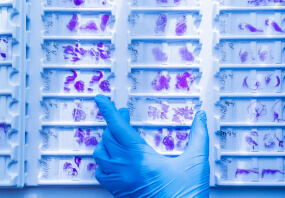Product descriptionPKH26 fluorescent cell connection kit adopts the company's patented membrane labeling technology, which can bind yellow-orange fluorescent dyes with longer lipid tails to the lipid regions of the cell membrane. The staining method depends on the type of cell and membrane, and is mainly used for cell labeling in vitro, cell proliferation research in vitro, and cell tracing research in vivo and in vitro. The kit provides the solvent (diluent C) required during the staining process, which can increase the solubility and staining efficiency of the dye during the staining process, while maintaining cell viability. Diluent C is isotonic with mammalian cells, and does not contain detergents or organic solvents, nor does it contain saline and buffer salts. According to the cell type and the internal changes of the cell membrane after labeling, the surface of the labelled cell will change from uniform and translucent to a little convex or patchy. However, in the physiological range, the fluorescence of PKH26 is not affected by pH, and the fluorescence intensity of each cell has nothing to do with the position of the dye label.PKH26 fluorescence is in the yellow-orange region (λex=551 nm, λem=567 nm), which can be used to label and track a variety of cells in vivo and in vitro. In cytotoxicity analysis, the purple, green, red and far infrared emitted by fluorescent protein, antibody or DNA dye in this area will not interfere with PKH26. PKH26 is most commonly used for dye dilution applications based on the analysis of dye dilution proliferation, including the establishment of antigen-specific precursor spectrum and the identification of quiescent or slow stem or progenitor cells in normal or tumor tissues. At the same time, PKH26 can also be used to monitor the uptake of foreign viruses, platelets and other nanoparticles; membrane distribution during stem cell division; cell-cell membrane transfer; cell phagocytosis; antigen presentation; adhesion; signals through gap junctions Transmission; and neuron migration in tissue sections. PKH26 has strong fluorescence stability, especially when the research period of labeled cells exceeds one week, PKH26 is used for in vivo cell tracking research.Product parameterEx(nm) 551 Em(nm) 567 Solvent: EthanolKit componentsPKH26 dye: 0.1mL Diluent C: 10mLPKH26 dye: 1mL Diluent C: 60mLStorage conditionsKeep away from light and refrigerate. Check the crystals before use. If there is crystals, dissolve them in a 37℃ water bath. Because it is stored in ethanol, it must be tightly covered to prevent volatilization.Ingredients: 1 bottle of PKH26 dye (>0.1ml, 1×10-3 M ethanol solution); Diluent C (1 bottle>10ml).Diluent C: Store at room temperature or in a refrigerator, without preservatives and antibiotics, and maintain sterility.Precautions● The working solution of the dye is ready for use. Do not store the prepared dye to affect the dyeing effect.●During the PKH26 staining process, there must be no azides or metabolic toxicants.●Although adherent cells can also be stained, a single cell suspension is best for uniform staining. Therefore, the staining effect is better after digesting adherent cells into single suspension cells with protease (trypsin/EDTA).●Remove serum and lipid before staining to improve staining effect.●The presence of salt can cause the dye to form particles and interfere with the dyeing reaction. Therefore, it is important to resuspend the cells before adding the dye. The dye should be added directly to the cell suspension, not to the cell mass.● Excessive cell labeling will result in loss of membrane integrity and decreased cell number. The cell and dye concentration in this sample is a reference concentration suitable for most cells, but the best dye/cell is determined by the user according to the cell type and experimental purpose. In addition, the user must also evaluate the cell viability (iodine excretion), fluorescence intensity, and fluorescence. Coefficient of variation of peak value, uniformity of dyeing.● The stain concentration varies according to the type of cell and the number of cells in each well. The number of generations or times that can be traced after different cell types are marked is quite different. Please make a test based on the actual situation or reference documents.Operation Note: Fast and uniform mixing is very important for marking. The following measures should be taken to obtain the best results:1) The cell suspension and working dye solution should be the same amount when mixing;2) Avoid staining too much (>5ml) or too little (<100ul) liquid. Avoid adding dye with a pipette stained with serum;3) The liquid volume should be as precise as possible to ensure that the cell and dye concentration are accurately replicated.4) The time that the dye and diluent act on the cells is as short as possible and has certain toxicity. The diluent can be used to act on the cells according to the above steps to see the degree of damage.5) Add the same amount of serum to terminate the reaction. Do not centrifuge the cells in Diluent C before terminating the staining reaction. Use serum-containing medium to increase the cleaning effect.6) The cells should be transferred to a new tube and centrifuged separately, and the culture medium should be used instead of Diluent C when washing 3 times.7) Ideal for marking in vitro stem cells, lymphocytes, monocytes, endothelial cells, etc.8) Whole cell labeling should precede the labeling of monoclonal antibody staining. The cell tracking probe will remain stable when the monoclonal antibody is stained at 4°C; if the labeling is followed by monoclonal antibody staining, the phenomenon of "blocking" is likely to occur.9) The stained cells are fixed with 2% paraformaldehyde and the stability is more than 3w.Materials neededUniform single cell suspension; serum-containing medium; serum-free medium or PBS without Ca2+Mg2+; serum, albumin or protein source compatible with the medium; polypropylene conical centrifuge tube; temperature controllable Centrifuge (0-1000g); fluorescence analyzer (fluorometer, fluorescence microscope, flow cytometer, fluorescence image analyzer); ultra-clean table; cell counter; glass slide.Steps. Related Documents: https://ald-pub-files.oss-cn-shanghai.aliyuncs.com/aladdinsci/pdp/sds/1/P266287-SCI_d6d886a5df03d7bd677566fec677cdae.pdf
- UPC:
- 51112014
- Condition:
- New
- Availability:
- 8-12 weeks
- Weight:
- 1.06 Ounces
- HazmatClass:
- No
- WeightUOM:
- LB
- MPN:
- P266287-0.1ml
- Product Size:
- 0.1ml















